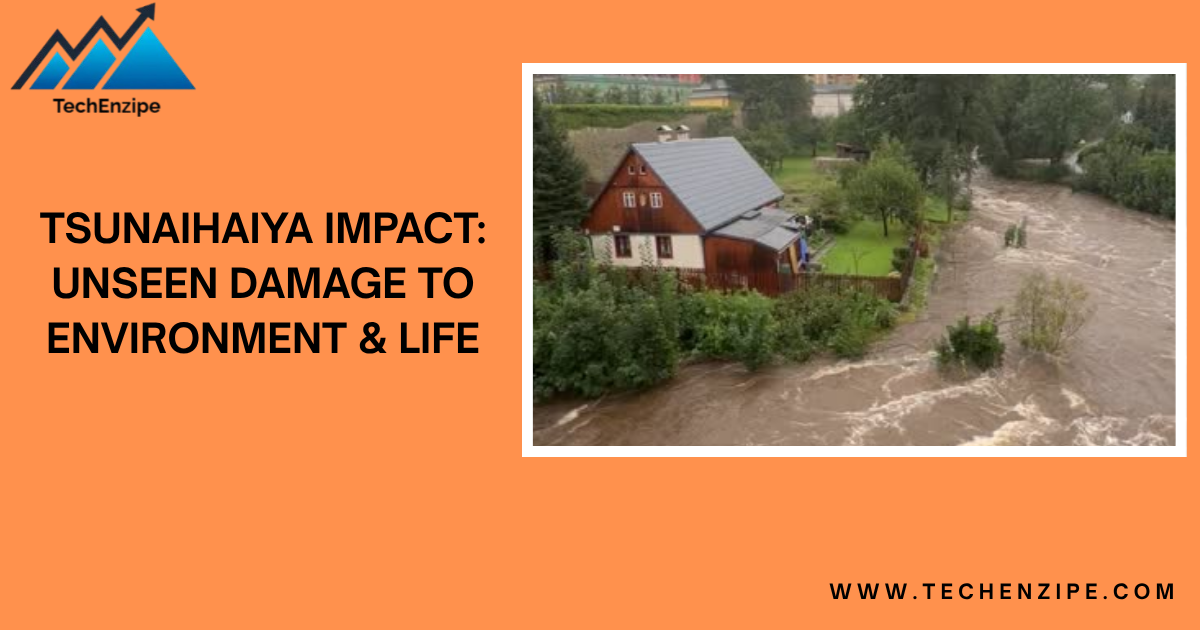Table of Contents
Introduction
Tsunaihaiya, which is frequently ignored when discussing natural disasters, can have far-reaching consequences that extend beyond the immediate destruction. Although the large waves attract the media attention, the invisible damage to the natural environment as well as human life can be equally destructive. From damaged coastlines, and altered marine ecosystems, to devastated communities and financial losses, it leaves a lasting effect that is often not noticed. It is vital to understand the implications in order to raise awareness, but also to develop efficient recovery and preparedness strategies. In this article we examine the many effects of Tsunaihaiya by examining the ways how it impacts the natural environment as well as human settlements and long-term sustainability.
Understanding Tsunaihaiya and its origins
What causes Tsunaihaiya? natural and man-made triggers
The natural disasters such as undersea earthquakes, volcanic eruptions and landslides which displace large volumes of water. Earthquakes that happen with the boundaries of tectonic plates can be particularly dangerous because they could cause waves that travel for thousands of kilometers in a few hours. However the triggers that are created by humans are less frequent and may resulty in explosions. large-scale underwater construction which could cause water to be displaced rapidly. It is very important to determine the risk zones and the prediction of potential areas for impact.
Historical events that shaped coastal areas
In the past, Tsunaihaiya events have reshaped landscapes and changed ecosystems. For example, the Indian Ocean Tsunami in 2004 is a stark reminder of the fury that nature uncovers which claimed over 230,000 lives and forced millions of people to relocate. Similar to the 2011 the Japan Tsunami not only caused immense loss of life but it also led to radiation contamination within the affected areas. The study about these disasters helps the researchers to develop warning systems and informs the urban coastal communities all over the world.
How does it affect the Marine ecosystems?
The environmental effect of Tsunaihaiya is vast, but many times not visible in the immediate aftermath. Coastal ecosystems such as coral reefs, mangroves and wetlands work as natural hurdles to the waves. But its strength could destroy these ecosystems in a matter of seconds which renders the coastlines at risk of future catastrophes.
Tsunaihaiya and coastal ecosystem destruction
Mangroves which protect from erosion of soil and provide nurseries for marine life are typically unrooted. Coral reefs are very important in protecting biodiversity and can be damaged by the pressure of waves. It can effect the marine life and human communities who depend on fishing for their livelihoods.
Soil erosion and long term land destruction
Beyond the immediate damage, Tsunaihaiya can strip fertile topsoil and render land not suitable to cultivate for a long time. The saltwater incursion further damages the groundwater and soil which can affect the agriculture and drinking water supply. Long-term degradation can result in damaging health and economics which results in an effect on the populations.
Marine life loss and habitat disruption
Tsunaihaiya waves do not just displace marine life, they also degrade the coral breeding areas and habitats. A vast range of species such as crustaceans, fish and turtles are subject to declining populations as a result of these events. Disturbance of ecosystems could destabilize fisheries in the local area impacting food security and source of income for people living along the coast.
What is the human cost of Tsunaihaiya?
Its impact on society can be devastating. Whole communities could be destroyed in just a few hours. And the psychological trauma can be felt for decades.
Communities affected: real-life stories
Stories from victors of the events such as those of the 2004 Indian Ocean Tsunami describe heart-wrenching tales of families that lost their houses, livelihoods and loved family members. A lot of survivors suffer from stress which requires the long-term care of mental health. Cohesion within communities is tested when the displacement of people forces them to temporary shelters or relocate zones.
Infrastructure damage: Roads, bridges and homes
Tsunaihaiya causes extensive infrastructure damage. Bridges and roads are destroyed, which makes relief operations difficult. Buildings and houses that are public in nature fall apart under the power of the storm and can cause chronic housing crises. The rebuilding process requires huge funds, and often strains the budgets of local and federal governments.
Economic consequences for coastal cities
The impact on the economy goes far beyond immediate destruction. Tourism, fishing, as well as trade are all affected. Coastal cities experience a decline in the economy as well as recovery may take a long time. The number of insurance claims increases dramatically and local economies suffer an effect that is a result of unemployment and a drop in income.
How can early warnings reduce its risks?
Early alert systems in their development are essential in limiting the damages that were caused by it. Technology advancements have enabled the detection of earthquake activity in the ocean and notify groups in real-time.
Early warning systems and technology
Sensors for seismic activity, tide gauges and satellite monitoring are part of the current Tsunaihaiya detection systems. Automatic alerts through radio, SMS, or sirens can help communities to evacuate in advance before the waves strike. Nations like Japan as well as Indonesia have been leading the way of integrating technology with public education in order to minimize the number of casualties.
How communities can reduce its risks
The community-based strategy includes creating mangrove forests, constructing seawalls as well as educating residents about evacuation routes. Urban planning plays an important part in preventing construction within areas at risk and enforcing strict building codes could save many lives. The practice of preparing for emergencies makes sure that the residents are able to respond slowly in emergency situations and minimize the loss of lives.
What steps are taken for environmental recovery?
Reconstruction after it is a lengthy and complicated procedure. The restoration of human as well as the natural systems is very important for preventing further destruction.
Rebuilding coastal ecosystems after it
The mangrove reforestation, coral reef restoration and the rehabilitation of wetland habitats are very important. This will help to restore natural barriers, enhance the biodiversity of our ecosystem as well as protect the future generations from similar catastrophes.
Government and NGO efforts in disaster recovery
The government agencies frequently work with non-governmental organizations to provide help and long-term restoration. It consists of repairing homes, schools, hospitals and providing psychological and financial assistance to affected communities. International help plays an important part in making sure that the efforts are effective and long lasting.
What are the advantages and drawbacks of Tsunaihaiya?
Benefits
The formation of New Landforms – Strong waves may deposit sediments which make the appearance of new islands or sandbars or even reshaped coastlines.
Nutrient Distribution: Tsunaihaiya may transport nutrient-rich sediments from the ocean into the inland and could improve the soil’s fertility and marine ecosystems over the long time.
Scientific Awareness: Each occasion promotes scientific research and leads to more effective earlier warning systems for disaster preparedness strategies.
Community preparedness: After large events, government agencies and communities typically strengthen structures and emergency response mechanisms.
Environmental Resets – In certain instances, ecosystems that are stagnant could be cleaned and renewed however this is not common and is often outweighed by the destruction.
Drawbacks
Loss of human life: One of the worst impacts of the event, with thousands dead or wounded during major disasters.
Destruction of infrastructure – Roads, bridges, houses, as well as public infrastructure are frequently removed, leading to the displacement of residents for a long time.
Economic damage- Coastal sectors like tourism, fishing and collapse of trade which resulted in billions being lost as damage and costs for recovery.
Environmental degradation – Destruction of Coral, reefs, mangroves, wetlands as well as marine habitats which may result in loss of biodiversity.
Soil and water contamination- Saltwater contamination damages agriculture and pollutes freshwater sources.
What is the future of Tsunaihaiya?
Experts believe that climate change, along with increasing sea levels will intensify the frequency and severity of Tsunaihaiya events. The growing urbanization of coastal areas increases the risk which makes the early warning system as well as sustainable development more vital than ever before. Future plans will likely focus on combining technology with ecological approaches that can reduce the environmental and human loss.
Frequently asked questions about it
What is Tsunaihaiya and what makes it distinct from regular tsunamis?
It is a term that is often used to describe huge waves that have a unique intensity or effect. Although it is similar to normal tsunamis, it may refer to specific events that have impacts on the environment or society.
Which regions are most at risk from it?
The coastal regions that are near to tectonic plate boundaries, volcanic zones and islands that are hidden and most at risk. Cities that are urbanized also have more economic and human risk.
How can people stay safe during it?
The safety measures can remove higher ground events by advance warning and having an emergency kit in place. Awareness and training programs can increase the chance of survival.
What steps are being taken to restore the environment?
Restoration consists of mangroves, coral, reefs, wetland and native plants to create natural barriers.
Can Tsunaihaiya be predicted correctly?
Although observation of oceanographic and seismic activity can improve predictions, this can not give 100% reliability. Timely warnings and public preparation can reduce injuries.
Conclusion
Tsunaihaiya creates a memorable effect on the earth and humanity. The impact causes immediate devastation, affects ecosystems, communities as well as economics for a long time. Being aware, ready and proactive to restore the environment for reducing the risk of future disasters. Through understanding the causes, consequences and strategies, communities can control devastation of it.

